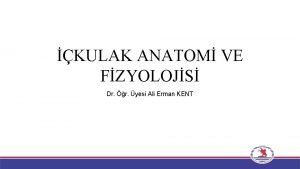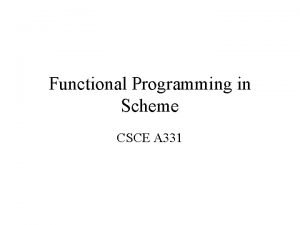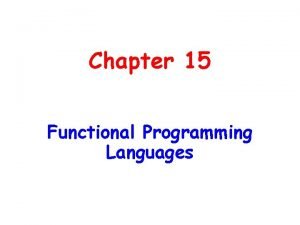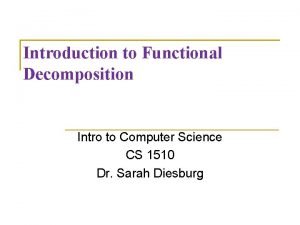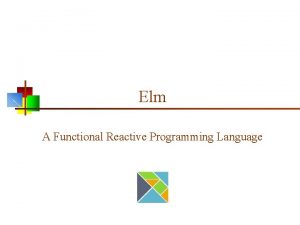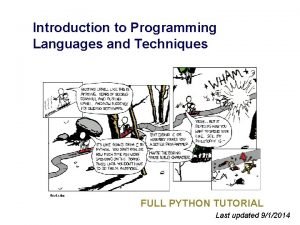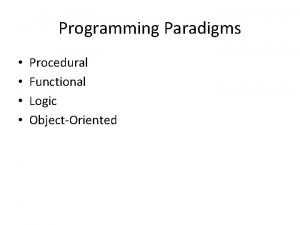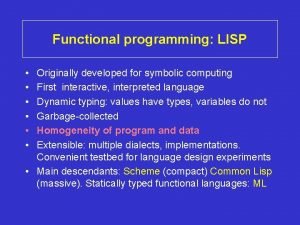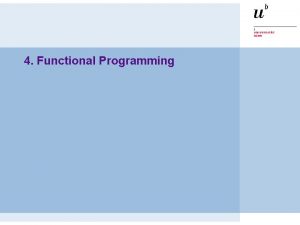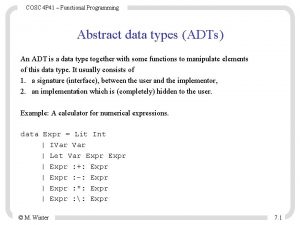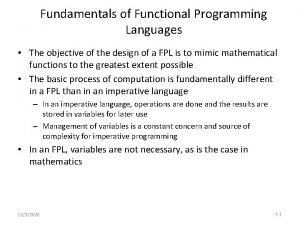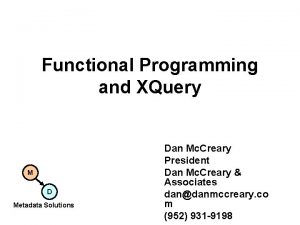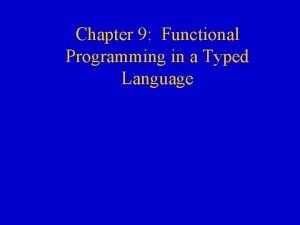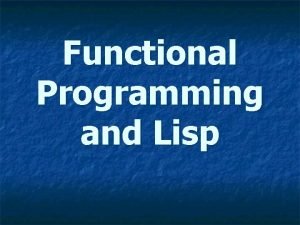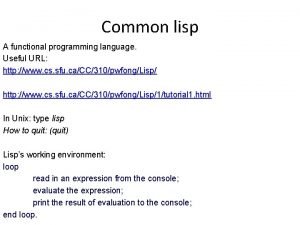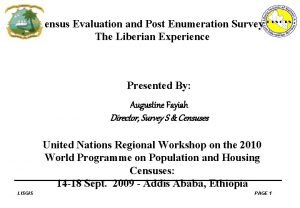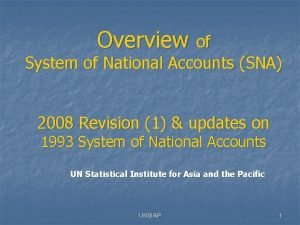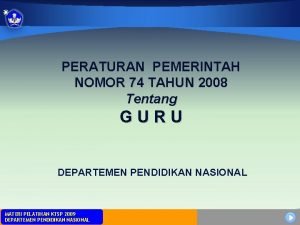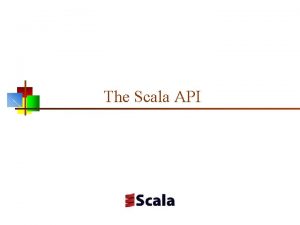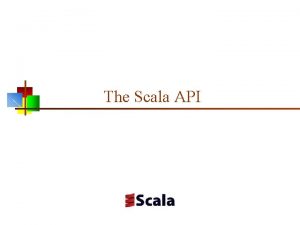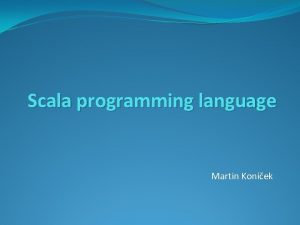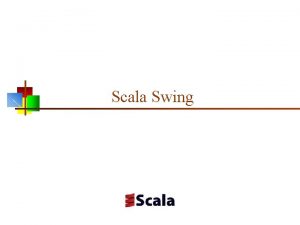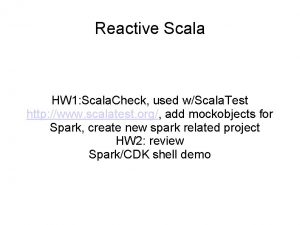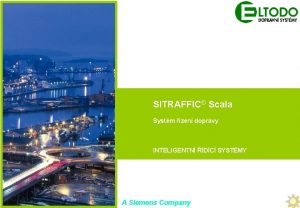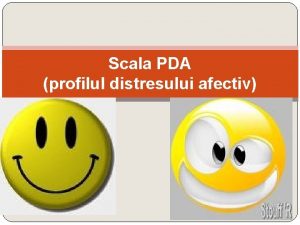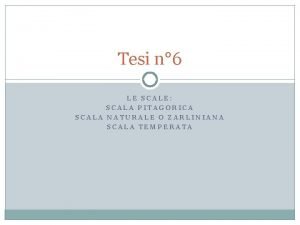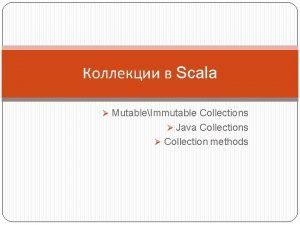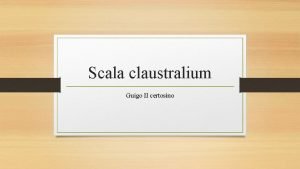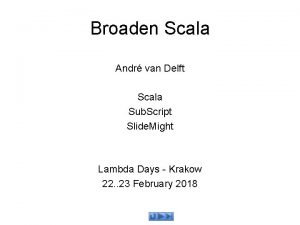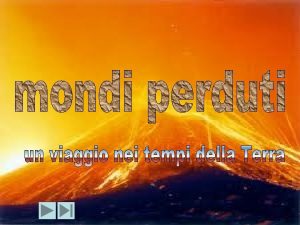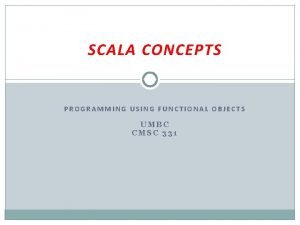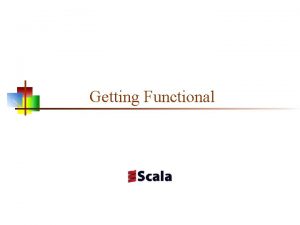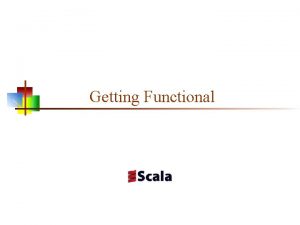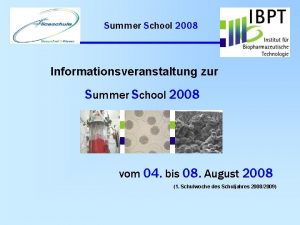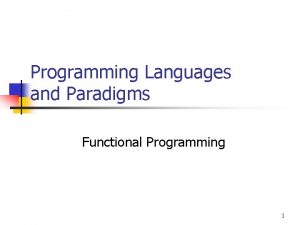Functional Programming in Scala Summer 2008 1 Functional






![A function object, defined with traits scala> class f extends Function 1[Int, Int] { A function object, defined with traits scala> class f extends Function 1[Int, Int] {](https://slidetodoc.com/presentation_image_h2/368f8d64a69c587afbbeb8e8d9e7771c/image-7.jpg)

























- Slides: 32

Functional Programming in Scala Summer 2008 1

Functional programming • One of the most interesting aims of Scala is the attempt to unify object-oriented and functional programming • What is functional programming then? A many different answers. Martin Odersky divides these into two categories 1: 1. Exclusive functional programming – programming without side-effects (e. g. Haskell) 2. Inclusive functional programming – programming style, which composes functions in interesting ways • Scala follows the latter approach 2

Contents • Contents of this talk 1. What’s a function 2. Local functions 3. First-class functions 4. Partially applied functions 5. Closures 6. Currying • Based on chapters 8 and 9 of the book ”Programming in Scala” 3

What’s a function? • Technically, a function in Scala is an object with a method with signature apply(…) • E. g: – apply(Int) is a function, which returns an Int – apply(String, Int) is a function, which takes one String parameter and returns an int – apply(String, Int) is a function, which takes one String parameter, one Int parameter and returns an Int – and so on. 4

Interpreter exercise scala> class func { | def apply(): Int = 6; |} defined class func scala> val f = new func(); f: func = func@c 192 f scala> f(); res 11: Int = 6 5

Functionn traits • For programmer convenience, the standard library defines n traits, which are named as Function 0 Function 1. . Function 15. . Function 22 • Why up to Function 22? • Twenty-one parameters ought to be enough for anybody. . 6
![A function object defined with traits scala class f extends Function 1Int Int A function object, defined with traits scala> class f extends Function 1[Int, Int] {](https://slidetodoc.com/presentation_image_h2/368f8d64a69c587afbbeb8e8d9e7771c/image-7.jpg)
A function object, defined with traits scala> class f extends Function 1[Int, Int] { def apply(arg: Int) = 6; } defined class f scala> val f = new f(); f: f = <function> scala> f(9); res 19: Int = 6 7

Theme 2/6: Local functions • With method placing, Java took the road of flat, one namespace, similar to C • The primary construct for reducing namespace pollution is the have private methods in classes • In Scala, there’s an alternative: local functions • Lexical scoping restricts the visibility of a local function 8

Long lines example – the Java style import scala. io. Source object Long. Lines { def process. File(filename: String, width: Int) { val source = Source. from. File(filename) for (line <- source. get. Lines) process. Line(filename, width, line) } private def process. Line(filename: String, width: Int, line: String) { if (line. length > width) println(filename +": "+ line. trim) } } 9

Translation to local functions object Long. Lines { def process. File(filename: String, width: Int) { def process. Line(filename: String, width: Int, line: String){ if (line. length > width) print(filename +": "+ line) } val source = Source. from. File(filename) for (line <- source. get. Lines) { process. Line(filename, width, line) } } 10 }

Local functions can access the names in the enclosing function object Long. Lines { def process. File(filename: String, width: Int) { def process. Line(line: String) { if (line. length > width) print(filename +": "+ line) } val source = Source. from. File(filename) for (line <- source. get. Lines) process. Line(line) } } 11

Theme 3/6: first-class functions • Functions are ’first-class citizens’: in addition to defining and calling functions – Functions can be passed around (easily) – Writing functions as literals is possible • Previously, we defined functions as objects with a method of certain signature • A function literal makes this much easier: scala> (x: Int) => x + 1 res 0: (Int) => Int = <function> • More than one expression in the function is done by curly braces (not so surprisingly!) 12

First-class functions and library support • A lot of Scala library has been written to with the support for first-class functions in mind • E. g the method foreach in the trait Iterable: it takes a function as an argument and invokes the function to each of the elements scala> val some. Numbers = List(-11, -10, -5, 0, 5, 10) some. Numbers: List[Int] = List(-11, -10, -5, 0, 5, 10) scala> some. Numbers. foreach((x: Int) => print(x)) -11 -10 -5 0 5 10 13

Interesting methods taking function parameters • foreach – as discussed on the previous slide • filter – takes a predicate function; drops falses • partition – takes a predicate function; returns two lists • map – apply the function to all elements and return a list containing the values of each invocation • fold. Right, fold. Left – higher order magic • A lot of expressiveness of functional programming comes from the ability of defining ’interesting’ functions, and applying the functions to a collection of values 14

Filtering example - repeated scala> some. Numbers. filter((x: Int) => x > 0) res 6: List[Int] = List(5, 10) scala> some. Numbers. filter((x) => x > 0) res 7: List[Int] = List(5, 10) scala> some. Numbers. filter(x => x > 0) res 8: List[Int] = List(5, 10) scala> some. Numbers. filter(_ > 0) res 9: List[Int] = List(5, 10) 15

The placeholder parameter _ • In function definitions, it is possible to use the underscore as a placeholders for one or more characters – As long as one parameter is used only once in the function definition • Multiple underscores mean multiple parameters, not reuse of a single parameter repeatedly. – The first _ refers to the first parameter – The second _ refers to the second parameter • So, (_ op _) is equivalent to (x, y => x op y) 16

The type inferer is not always smart enough • The type inferer is not always able to know the types of the parameters. • Usually they’re blaming the Java’s erasure • Fix: (_: Int) + (_: Int) (x: Int, y: Int => x + y) • Beautiful? Or perl? 17

Theme 4/6: Partially applied functions • When using the underscore as the placeholder for a parameter, we’re actually using partially applied functions • Usually, when a function is invoked, all of its arguments are given scala> def sum(a: Int, b: Int, c: Int) = a + b + c sum: (Int, Int)Int scala> sum(1, 2, 3) res 12: Int = 6 • A partially applied function is expression, where not all of the arguments are supplied 18

Defining a partial sum of 1, x and 3 • Let’s define a function b, which calculates the sum scala> val b = sum(1, _: Int, 3) b: (Int) => Int = <function> • Now, we can call the function with just one argument: scala> b(6) res 36: Int = 10 19

When to leave out the underscore • When used in a context, where a partially applied function is expected, it is possible to leave out the underscore scala> some. Numbers. foreach(println _) • Can be also written as scala> some. Numbers. foreach(println) • When the context doesn’t mandate the partially applied function, leaving out the underscore is a compilation error (which is fixed by adding the _) scala> sum <console>: 5: error: missing arguments for method sum. . . 20

Time for fold. Left • A fold left operation (start. Value /: list) (bin. Op) • Result of the operation is successive application of bin. Op, prefixed with start. Value • So, (z /: List(a, b, c)) (op) equals op(op(op(z, a), b), c) • Or graphically: 21

Theme 5/6: Closures • Java 7 – the Java version with Closures. Except that the latest news say that they’re dropping the closures. • Scala – has closures, available today • What’s a closure? A function, in which the free variables are bound. • E. g. scala> (x: Int) => x + more <console>: 5: error: not found: value more (x: Int) => x + more 22

A closure binds its free variables scala> var more = 1 more: Int = 1 scala> val add. More = (x: Int) => x + more add. More: (Int) => Int = <function> scala> add. More(10) res 0: Int = 11 23

What happens, if the referred variables have changed? scala> more = 9999 more: Int = 9999 scala> add. More(10) res 21: Int = 10009 • Scala’s closures capture the variables themselves • This is different than in Java’s inner classes, which do not allow accessing modifiable variables in the surrounding scopes. . – Making it indistinguishable from capturing the values of the variables • If there are multiple variables with the same name, which one is beign accessed in closures? – The one that was active at the time of closure creation 24

Some closures examples • Calculating the sum of integers in a list scala> var sum = 0 sum: Int = 0 scala> some. Numbers. foreach(sum += _) • A new increaser closure is constructed at each invocation: scala> def make. Increaser(more: Int) = (x: Int) => x + more make. Increaser: (Int) => Int scala> val inc 1 = make. Increaser(1) inc 1: (Int) => Int = <function> 25

Theme 6/6: Currying • Currying is a functional programming technique, in which calculation is defined by a chain of function applications • E. g. The plain old way to calculate sum of two integers: scala> def plain. Old. Sum(x: Int, y: Int) = x + y plain. Old. Sum: (Int, Int)Int scala> plain. Old. Sum(1, 2) res 4: Int = 3 26

Calculating the sum via currying • In currying, the calculation is contains two function invocations 1. Invoking a function with the first argument, returning a partially applied function back 2. Invoking the partially applied function with the second argument scala> def curried. Sum(x: Int)(y: Int) = x + y curried. Sum: (Int)Int scala> curried. Sum(1)(2) res 5: Int = 3 27

Currying example – step-by-step • Defining the first function scala> def first(x: Int) = (y: Int) => x + y first: (Int) => Int • Applying 1 to the first function yields the second function scala> val second = first(1) second: (Int) => Int = <function> • Applying 2 to the second function yields the end result scala> second(2) res 6: Int = 3 28

Wrapping it up – a final example • Example problem: to calculate the distance of n places, which are contained in a list • Assume that we have the function distance(place 1, place 2) • Lists are defined as List(1, 5, 9) 29

Distance calculation in Java-style var sum = 0; var current. Place = list. head; for(arg <- list. tail) { val distance = distance(current. Place, arg); sum = sum + distance; } return sum; 30

Distance calculation in a more functional style • An exercise left to the reader – Hints: you need partial application, fold. Left /: and List. map 2 31

References 1. M. Odersky – In defence of pattern matching http: //www. artima. com/weblogs/viewpost. jsp? thread=166742 32
 2008 2008
2008 2008 Kemik labirent
Kemik labirent Cavitas tympani arka duvarı
Cavitas tympani arka duvarı Scala vestibuli
Scala vestibuli Perbedaan linear programming dan integer programming
Perbedaan linear programming dan integer programming Perbedaan linear programming dan integer programming
Perbedaan linear programming dan integer programming Greedy vs dynamic programming
Greedy vs dynamic programming What is system programing
What is system programing Linear vs integer programming
Linear vs integer programming Scheme functional programming
Scheme functional programming Fundamentals of functional programming language
Fundamentals of functional programming language Functional decomposition programming
Functional decomposition programming Elm lang
Elm lang Xkcd software development
Xkcd software development Procedural vs functional
Procedural vs functional Lisp functional programming
Lisp functional programming Functional programming roadmap
Functional programming roadmap Adt functional programming
Adt functional programming Functional programming fundamentals
Functional programming fundamentals Functional programming
Functional programming Typed functional programming
Typed functional programming Lisp functional programming
Lisp functional programming Is lisp a functional programming language
Is lisp a functional programming language Non functional space maintainer
Non functional space maintainer Non functional plasma enzyme
Non functional plasma enzyme Plasma enzymes
Plasma enzymes Functional and non functional
Functional and non functional Liberia census 2008 results
Liberia census 2008 results Primavera 2008
Primavera 2008 System of national accounts (sna)
System of national accounts (sna) Xcelsius 2008
Xcelsius 2008 Pp no 74 tahun 2008 tentang guru
Pp no 74 tahun 2008 tentang guru 12.02.2008 nasa
12.02.2008 nasa

